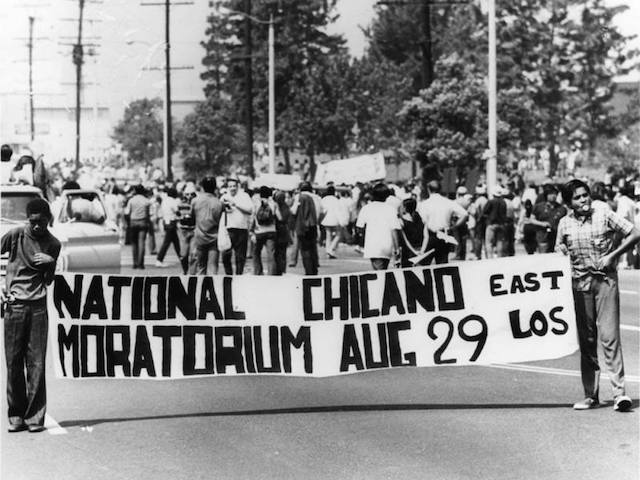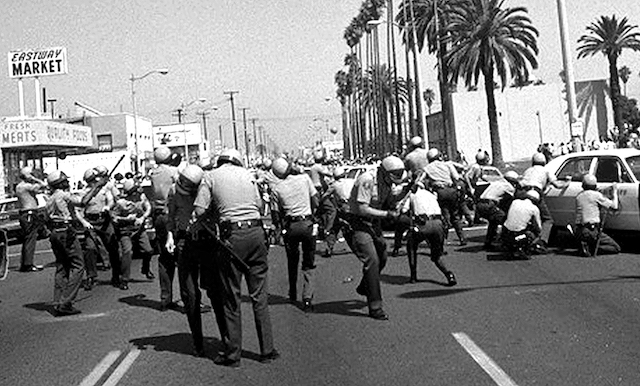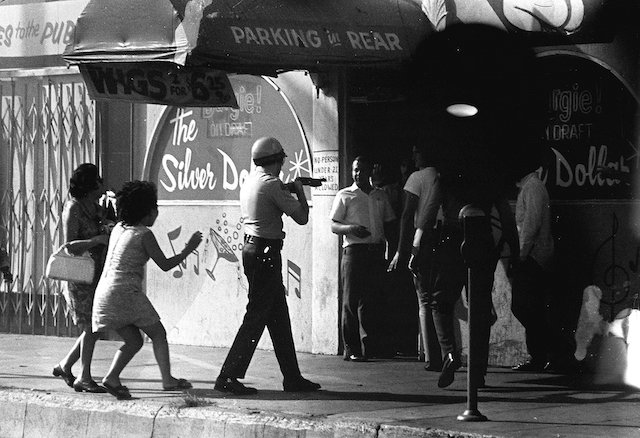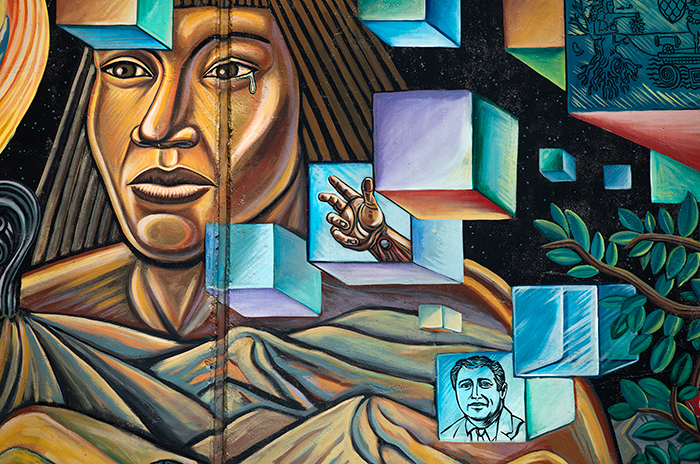A Day of Rage in East L.A.

Simmering anger over brutal policing, unequal education and racist neglect finally explodes.
Grass-roots activists knew that East Los Angeles’ sprawling Mexican American barrio was a community on edge.
For years they had seen bitterness and frustration fester over police brutality, underfunded schools with some of the worst drop-out rates in the nation, biased media coverage, freeway construction that replaced 3,000 homes, and a disproportionate number of Mexican American soldiers returning from Vietnam in body bags.
But even the activists were not prepared for the fury of street warfare that erupted on the hot, smoggy Saturday afternoon of Aug. 29, 1970, when deputies used tear gas and clubs to disperse an anti-Vietnam War demonstration at Laguna Park after responding to a minor disturbance at a nearby liquor store.
The Times is taking a look back at the legacy of the Chicano Moratorium in 1970. See more stories
The biggest, bloodiest disturbance in Los Angeles since Watts five years earlier lasted several hours. When it was over, Los Angeles Times columnist Ruben Salazar was dead and two others mortally wounded, about 200 people were under arrest, 75 law enforcement officers and untold numbers of demonstrators were injured, 95 county vehicles were destroyed or damaged, 44 buildings were pillaged and eight major fires had been set.
For decades, activists and students of Latino history have marked the anniversary of the unrest, and they will do so again this month, the 50th anniversary of that day of rage.
The commemorations of the movement known as the National Chicano Moratorium Against the Vietnam War have tended to focus on the death of Salazar, then a rare Latino voice in mainstream media. But there’s so much more that should be remembered about the day the Eastside demanded to be heard.
The National Chicano Moratorium march began at Belvedere Park near 3rd Street and Fetterly Avenue at about 9 a.m. amid a fiesta atmosphere of vivas! and placards reading “Aztlan: Love it or Leave it!” and “Stop Chicano Genocide.”
Once a pejorative term among Mexican Americans, “Chicano” was embraced by a new generation as an emblem of ethnic pride, cultural awareness and commitment to community.
The march, which drew about 20,000 demonstrators from across the nation, followed a route down Atlantic Boulevard to Whittier Boulevard, then west past bustling restaurants, small markets, appliance stores, carnicerias and panaderias, which filled the air with the aroma of fresh Mexican bread.

The march ended without incident, and participants headed for Laguna Park, where a rally was scheduled that afternoon.
“Picture this in your mind’s eye,” recalled Frank Villalobos, an architect and president of Barrio Planners, which develops community projects throughout Los Angeles. “It’s a sunny day, and thousands of young Latinos clad in the gear of the day — bell-bottom jeans, tie-dye shirts and headbands — are streaming into Laguna Park after a long, hot march and plopping down on the grass.”
Conjuntos blared out corridos. Before the advent of bottled water, workers from tienditas, or local stores, handed out cups of water to thirsty demonstrators as they trundled into the park with their families.
Militant Brown Berets guided people toward a stage to wait for speakers, including United Farm Workers leader Cesar Chavez and Rodolfo “Corky” Gonzales, a former boxer whose fiery advocacy of Chicano power made him a hero to Mexican American youths in the 1960s.
The first signs of trouble occurred a block away when people crowded inside the Green Mill Liquor Store. At about 1:30 p.m. the owner, Morris Maroko, called police and complained that teenagers had stolen soft drinks. He would later tell the Times that the youths had threatened him.
Los Angeles County Sheriff’s deputies who rushed in with sirens blaring were pelted, Villalobos said, by a hail of “rocks and Bubble Up and Double Cola soda bottles — remember how big those things were? — thrown by people in an angry crowd.”
David Sánchez, founder of the Brown Berets, recalled crossing paths with Salazar amid the commotion.
“Ruben stood out in the crowd because he was wearing a silk shirt, navy blue trousers and shined shoes, so I said, ‘Hey man, you’re not dressed right for this kind of thing,’” Sánchez said. “Ruben laughed and said, ‘I’m not worried.’”
Salazar had a few hours left to live.
The tumult spread toward the park, where about 40 officers were lined up with riot batons across their chests. The crowd surged forward, was pushed back by deputies, then surged forward again.

More deputies arrived to reinforce the skirmish line, which was collapsing in the confusion. Tear gas canisters exploded. Demonstrators ran for cover or stood and fought.
“We had heard through the grapevine that gangs were coming out to fight that day,” Sánchez said. “In other words, the issue of police brutality in East L.A. had finally come down to a showdown.”
Ismael “Smiley” Perera was among the young Chicanos who had come looking for trouble that day and found it. “We duked it out with the cops and it was a righteous feeling,” he told The Times five years later. “It was like I got years of frustration and hate out of me that day.”
Violence swept with breathtaking speed along Whittier Boulevard.
At 3 p.m., sheriff’s officials issued an urgent call directing as many units as possible from throughout the county to Laguna Park. By 3:30 p.m., deputies established roadblocks to prevent any vehicles from entering the battle zone.
A 3-square-mile area — bounded roughly by the Pomona Freeway on the north and Olympic Boulevard on the south — was the scene of people running for cover and riot-equipped police in gold-colored helmets and gas masks advancing in military formations, trampling spectators and clubbing those who did not move fast enough. For many in the community, it confirmed their complaints of abusive and indifferent law enforcement.
If you love Los Angeles, support our journalism.
The Times is dedicated to covering everything about our city, whether taking a hard look at its past or at what's going on today. Get unlimited digital access. Already a subscriber? Your contribution helps us make projects like this possible. Thank you.
Among the demonstrators was 15-year-old Lynn Ward of El Monte, who served as a Brown Beret “medic,” carrying first-aid supplies in case, as Sánchez put it, “things went wrong.”
Sánchez recalled that Ward was in good spirits when he showed up wearing a bush jacket and beret — the headgear seen on countless posters of Latin American revolutionary Che Guevara. He was small, barely over 5 feet 6 and 133 pounds.
“Lynn told me that he really wanted to be out there on Aug. 29,” Sánchez said. “But our role that day was not to provide security. Our job was simply to display our presence and protest the war.”
It may never be known whether Ward knew that Brown Beret leaders later raced up and down the boulevard like military officers in urgent retreat, screaming, “Pull out! Pull out!’”
A medical examiner’s report would say that Ward was “reportedly getting on his motorcycle in midafternoon” — the exact time was unclear — when “someone allegedly threw a Molotov cocktail at him.” Other accounts say someone tossed an incendiary device into a trash can.
Whatever the cause, a blast hurled Ward into the air 38 feet and through the plate-glass window of a store, Velasquez Tortilleria.
That tortilleria at 4112 Whittier Blvd. was owned by my grandmother, Juanita Velasquez — a detail I learned while investigating Ward’s death for this article.
Ward, who suffered severe burns and a mangled right leg that was later amputated, was initially treated at a first-aid stand set up across Whittier Boulevard from East Los Angeles Doctors Hospital.
At 88, my mother’s memories have faded in time. But she remembers visiting the tortilleria a few days after the unrest ended.
“When I walked into the store,” she recalled, “Mom was sweeping up broken glass. She looked at me with sadness in her eyes and said, ‘Mira como dejaron aquí.’” Look what they’ve done.
“I’ll help you clean it up, mom,” my mother said, then set to work.
There was more chaos to come. At about 4 p.m., firefighters and deputies continued to be pummeled with bricks, rocks and bottles as they tried to respond to flashpoints, including a county fire station under siege at the corner of Eastman Avenue and Verona Street. They arrived to find every window broken and files burning in front offices. In the driveway, a squad car was engulfed in flames.
Billows of smoke rose above a 3 -mile stretch of Whittier Boulevard that cuts through the heart of East L.A.’s commercial district as police with bullhorns ordered people to leave the area.
That was not an easy order to follow, Villalobos recalled.
“Demonstrators from out of town found themselves trapped in East L.A.’s unfamiliar maze-like geography of narrow neighborhood streets, restricted cemeteries and impassable freeways,” he said. “Getting back to cars and buses parked miles away was a terrifying ordeal amid the chaos.”
Afraid and desperate, “some people looked for places to hide,” he said. “Many others poured back onto Whittier Boulevard, where buildings burned out of control and caravans of police vehicles were slithering like snakes at high speed to break up the crowds.”
In some cases, tear gas blew inside buses that had brought demonstrators from out of state. The occupants gasped for air until the drivers could get the vehicles moving.
The violence reached a new level at 4:20 p.m. when 35-year-old Angel Diaz barreled toward a police roadblock at Whittier Boulevard and Esperanza Street in a white 1960 Valiant. Diaz blew through the intersection and then through another roadblock a few blocks away at Calzona Street.
Continuing east on Whittier, the Valiant swerved toward deputies who leaped out of the way. One deputy whacked the car with his billy club as it sped past. The area was still crowded with demonstrators, but five other deputies fired one round each. “I aimed for the driver’s head,” Deputy Allen B. Mills told a coroner’s inquest.
Diaz turned right at Eastman and headed toward a dozen officers guarding the burning fire station. Deputy Roger Jewell told the inquest, “I raised my hand, the driver ducked beneath the dash. I raised my pistol, steadied it with my left hand and fired three times.”
It’s unclear which deputy fired the key shot, but one bullet struck Diaz in the back of the neck. He slumped and crashed into a telephone pole, sending sparks flying from the wires.

About 35 minutes after Diaz crashed, deputies responding to a report of two armed men inside the Silver Dollar Bar & Cafe converged on the bar a mile and half to the east on Whittier Boulevard. The report was false, but among those inside was Salazar, 42, taking a break from covering the unrest. His head was shattered by a heavy torpedo-shaped tear gas projectile fired by Deputy Thomas Wilson, the acting sergeant at the scene.
It was the way Salazar died that made him a martyr to many in the Mexican American community. As a Times columnist and news director of television station KMEX he had spoken out against the oppression of Mexican Americans, and some in the community to this day believe he was assassinated and not, as an official inquiry found, the victim of a tragic accident.
Salazar died instantly and his body was not removed from the bar until 7 p.m. The unrest finally quieted down about an hour after that.
By then Diaz was at USC-County Medical Center and still unconscious when authorities booked him on assault with a deadly weapon on a police officer. Diaz, who had a lengthy criminal record dating to 1953, died three days later.
Ward, the 15-year-old Brown Beret, died on Sept. 9, the eve of a televised inquest into the slaying of Salazar.
Two poignant tangible symbols born out of strife on Aug. 29, 1970, and the soul searching that followed, remain to this day.
On Sept. 17, 1970, Laguna Park was renamed in honor of Salazar, whose death was compared by many Latinos to the assassinations of the Kennedy brothers and of the Rev. Martin Luther King Jr.

Around the same time, the East Los Angeles Sheriff’s station adopted a new logo. Beneath the title “Fort Apache,” it features an image of a boot with a riot helmet and a Spanish phrase, “Siempre una patada en los pantalones, which means “Always a kick in the pants.”
Critics say the emblem casts the station as a Wild West outpost of deputies who crack down on local Latinos. But Sheriff Alex Villanueva, who served at the station for seven years, says it is a source of pride.
The massive demonstration was seen as an extraordinary achievement of the Chicano civil rights movement, a new force on the political scene that, much like Black Lives Matter today, focused attention on fundamental problems in basic institutions in American society — the education system, the administration of justice, the political process and military service.
But much of the sympathy and concern it generated erupted in anger that transformed East L.A. into an urban battleground.
Five years later, Eduardo Aguirre, an ex-con who headed a local addiction recovery program, mused that “the violence did bring all our problems out into the open. But was it worth nearly destroying our community to do it?”
That remains a tough question to answer.
“Organizing the massive demonstration of Mexican Americans’ opposition to the Vietnam War was a huge achievement for the Chicano movement,” Mario T. Garcia, a professor at UC Santa Barbara, said. “But it turned into a riot, which had the ironic effect of tagging the movement as violent even though deputies had caused most of the trouble.”
“The Chicano movement,” he added, “never fully recovered.”
Hear more from Times journalists. Watch our forum
The Times hosted a virtual forum on the Chicano Moratorium that featured authors of the series, including Daniel Hernandez, Carolina A. Miranda and Robert J. Lopez. Watch recordings via The Times Facebook page, YouTube or Twitter.